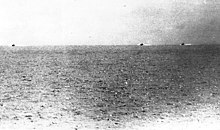
Back حادث خليج تونكين Arabic Tonkin körfəzi olayı Azerbaijani Tonkin-Zwischnfoi BAR Інцыдэнт у Танкінскім заліве Byelorussian Тонкински инцидент Bulgarian Incident del golf de Tonquín Catalan Incident v Tonkinském zálivu Czech Tonkin-episoden Danish Tonkin-Zwischenfall German Incidente del golfo de Tonkín Spanish
| Gulf of Tonkin incident | |||||||
|---|---|---|---|---|---|---|---|
| Part of the Vietnam War | |||||||
 Photo taken from USS Maddox during August 2 encounter, showing three North Vietnamese motor torpedo boats. | |||||||
| |||||||
| Belligerents | |||||||
|
|
| ||||||
| Commanders and leaders | |||||||
| |||||||
| Strength | |||||||
| 3 torpedo boats | ||||||
| Casualties and losses | |||||||
|
| ||||||
The Gulf of Tonkin incident (Vietnamese: Sự kiện Vịnh Bắc Bộ) was an international confrontation that led to the United States engaging more directly in the Vietnam War. It consisted of a confrontation on August 2, 1964, when United States forces were carrying out covert amphibious operations close to North Vietnamese territorial waters, which triggered a response from North Vietnamese forces. The United States government falsely claimed that a second incident occurred on August 4, 1964, between North Vietnamese and United States ships in the waters of the Gulf of Tonkin. Originally, US military claims blamed North Vietnam for the confrontation and the ostensible, but in fact imaginary, incident on August 4. Later investigation revealed that the second attack never happened. The National Security Agency, an agency of the US Defense Department, had deliberately skewed intelligence to create the impression that an attack had been carried out.[5][6][7]
On August 2, 1964, the destroyer USS Maddox, while performing a signals intelligence patrol as part of DESOTO operations, was approached by three North Vietnamese Navy[8] torpedo boats of the 135th Torpedo Squadron.[1] Maddox fired warning shots and the North Vietnamese boats attacked with torpedoes and machine gun fire. In the ensuing engagement, one U.S. aircraft (which had been launched from aircraft carrier USS Ticonderoga) was damaged, three North Vietnamese torpedo boats were damaged, and four North Vietnamese sailors were killed, with six more wounded. There were no U.S. casualties.[9] Maddox was "unscathed except for a single bullet hole from a [North] Vietnamese machine gun round".[5]
On August 3, 1964, destroyer USS Turner Joy joined Maddox and the two destroyers continued the DESOTO mission. On the evening of August 4, the ships opened fire on radar returns that had been preceded by communications intercepts, which US forces claimed meant an attack was imminent. The commander of the Maddox task force, Captain John Herrick, reported that the ships were being attacked by North Vietnamese boats when, in fact, there were no North Vietnamese boats in the area. While Herrick soon reported doubts regarding the task force's initial perceptions of the attack, the Johnson administration relied on the wrongly interpreted National Security Agency communications intercepts to conclude that the attack was real.[5]
While doubts regarding the perceived second attack have been expressed since 1964, it was not until years later that it was shown conclusively never to have happened. In the 2003 documentary The Fog of War, the former United States Secretary of Defense, Robert S. McNamara, admitted that there was no attack on August 4.[10] In 1995, McNamara met with former North Vietnamese Army[11] General Võ Nguyên Giáp to ask what happened on August 4, 1964. "Absolutely nothing", Giáp replied.[12] Giáp confirmed that the attack had been imaginary.[13] In 2005, an internal National Security Agency historical study was declassified; it concluded that Maddox had engaged the North Vietnamese Navy on August 2, but that the incident of August 4 was based on bad naval intelligence and misrepresentations of North Vietnamese communications.[5] The official US government claim is that it was based mostly on erroneously interpreted communications intercepts.[14][15]
The outcome of the incident was the passage by U.S. Congress of the Gulf of Tonkin Resolution, which granted U.S. President Lyndon B. Johnson the authority to assist any Southeast Asian country whose government was considered to be jeopardized by communist aggression. The resolution served as Johnson's legal justification for deploying U.S. conventional forces to South Vietnam and the commencement of open warfare against North Vietnam.
- ^ a b Moïse 2019, p. 78.
- ^ Moïse 2019, p. 93.
- ^ Moïse 2019, p. 94.
- ^ Moïse 2019, pp. 95–96, 105.
- ^ a b c d Cite error: The named reference
Ha01was invoked but never defined (see the help page). - ^ Fujimoto, Hiroshi (2014). "The Legacy of the Gulf of Tonkin Incident". Nanzan Review of American Studies. 36: 113–121 – via Connecting Repositories.
- ^ Paul, Erik Charles (2012). "The Construction of East Asia". Neoliberal Australia and US imperialism in East Asia. Basingstoke: Palgrave Macmillan. pp. 114–145. doi:10.1057/9781137272782. ISBN 9781137272775.
- ^ Starry. Department of the Army. 1978. P. 248
- ^ Moïse 2019, pp. 94–96, 105.
- ^ "Film: The Fog of War: Transcript". Errol Morris. Retrieved June 28, 2021.
McNamara: "It was just confusion, and events afterward showed that our judgment that we'd been attacked that day was wrong. It didn't happen. And the judgment that we'd been attacked on August 2nd was right. We had been, although that was disputed at the time. So we were right once and wrong once. Ultimately, President Johnson authorized bombing in response to what he thought had been the second attack ? It hadn't occurred, but that's irrelevant to the point I'm making here. He authorized the attack on the assumption it had occurred…"
- ^ Starry. Department of the Army. 1978. p. 248
- ^ McNamara asks Giáp: What happened in Tonkin Gulf? Archived March 6, 2015, at the Wayback Machine, Associated Press, 1995
- ^ Cite error: The named reference
:0was invoked but never defined (see the help page). - ^ Cite error: The named reference
:1was invoked but never defined (see the help page). - ^ Cite error: The named reference
:2was invoked but never defined (see the help page).